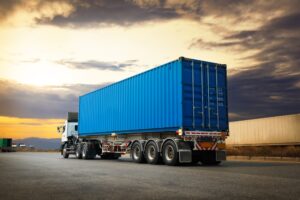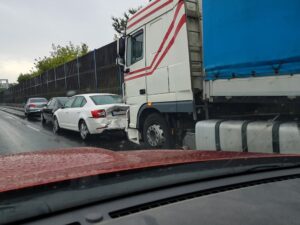Driving alongside a semi-truck can be an intimidating experience, given the stark contrast in size and weight compared to passenger vehicles. Commercial trucks, often weighing up to 80,000 pounds, tower over other cars on the road, and when accidents occur, they can lead to devastating outcomes. Investigations into these incidents frequently point to issues such as driver error or oversight by trucking companies as contributing factors.
This blog post will explore common types of truck accidents that occur on the roads, shedding light on the risks and how they happen.
If you were involved in an accident with a commercial truck, understanding these common scenarios can be the first step towards seeking help and guidance from a truck accident lawyer.
Types Of Truck Accident :
Jackknife Accidents

Jackknife accidents are among the most dramatic and hazardous types of incidents involving semi-trucks. They occur when the semi-truck folds at the point where the cab and the trailer are connected, creating a sharp 90-degree angle. This type of accident gets its name from its visual resemblance to a folding pocket knife.
The mechanics behind a jackknife accident typically involve abrupt and forceful braking by the truck driver. When the brakes are applied too harshly, the trailer's momentum continues forward, overwhelming the traction of the cab's tires against the road surface. This imbalance in momentum and traction causes the trailer to swing out and form an acute angle with the cab.
Several factors can contribute to jackknife accidents. Slippery road conditions due to rain, snow, or ice can reduce the effectiveness of the truck's brakes and traction, increasing the risk of the trailer swinging uncontrollably.
Additionally, improper braking techniques or a truck driver's lack of experience can lead to situations where jackknifing is more likely. Overloading the trailer or unevenly distributing the cargo weight can also play a significant role in these accidents, as the extra weight can exacerbate the loss of control during sudden braking.
Tire Blowouts
Tire blowouts are a safety issue in commercial trucking, posing significant risks not only to truck drivers but also to all road users nearby. These incidents occur when a tire suddenly bursts or deflates, often as a result of the immense stress and pressure these tires endure over long distances and heavy loads.
The results of a tire blowout on a commercial truck can be particularly chaotic and dangerous. The immediate loss of control by the driver can lead to unpredictable vehicle movements, including swerving across lanes or even overturning, especially if the driver reacts abruptly or panics. Such reactions increase the potential for collisions with other vehicles, creating a cascade of hazardous situations on the road.
Additionally, the debris from the blown-out tire itself is a hazard. Large tire pieces can scatter across the roadway, creating obstacles that vehicles must swiftly navigate. Drivers may have to perform sudden maneuvers to avoid these tire remnants, leading to further accidents or close calls. The risk is amplified on high-speed roads or highways, where the reaction time and space to safely maneuver are severely limited.
Wide Turns by Large Commercial Trucks

Maneuvering large commercial trucks during turns, particularly right turns, is a complex task requiring skill and precision. Due to their extensive length, these vehicles often need to initiate a wide turning radius, which can inadvertently lead to accidents involving other road users. This is especially true in urban environments or tight intersections with limited space.
Truck drivers might first swing their vehicle to the left to successfully execute a right turn. This maneuver is necessary to accommodate the truck's lengthy trailer and ensure it clears obstacles and curbs during the turn. However, this action can be hazardous for nearby vehicles and pedestrians, who may not anticipate the truck's movement or find themselves in the truck's blind spots. The area immediately to the right of the truck becomes particularly dangerous as the turn is executed, posing risks to those who might be caught unaware by the truck's path.
The issue of blind spots is a significant concern in these scenarios. Large commercial trucks have extensive blind spots on all four sides, with the areas immediately to the side and rear being particularly problematic.
Motorists and pedestrians located in these blind spots may not be visible to the truck driver, increasing the likelihood of an accident. When a truck swings left before making a right turn, vehicles that were previously visible to the truck driver can suddenly disappear into these blind spots.
Another risk arises when vehicles or pedestrians on the right side of the truck get trapped as the turn is made. If a driver or pedestrian is positioned between the truck and the curb as the truck begins its turn, they may find themselves with no escape route, leading to potentially dangerous situations. Such incidents can result in serious injuries or even fatalities, especially for pedestrians or cyclists who are more vulnerable.
Truck Rollover Accidents
Truck rollover accidents are among the most severe and dramatic incidents on the road, often resulting in significant damage and injury. These accidents occur when a commercial truck tips over onto its side or roof, potentially causing catastrophic outcomes for the truck driver and nearby motorists and passengers.
The dynamics leading to a rollover can vary, but they often involve a loss of control by the truck driver. This loss of control can be triggered by several factors, including excessive speed, abrupt maneuvers, improper loading of cargo, or navigating curves with too much velocity. When the truck's center of gravity is shifted too far to one side, due to any combination of these factors, the risk of a rollover is significantly increased.
The consequences of truck rollover accidents are particularly dire. The sheer size and weight of a commercial truck mean that when it rolls over, it can cover a wide area, impacting multiple lanes of traffic and any vehicles within those lanes. The unpredictability of a rollover incident also means that other drivers have little time to react, potentially leading to secondary collisions as they attempt to avoid the initial accident.
Also, the cargo being hauled by the truck can add another layer of danger, especially if it consists of hazardous materials. In such cases, a rollover can lead to spills that pose environmental risks and health hazards, requiring extensive cleanup efforts and possibly leading to long-term road closures.
Preventing truck rollover accidents requires a concerted effort from all stakeholders in the trucking industry. This includes rigorous driver training focused on safe handling practices and speed management, especially in conditions that increase the likelihood of rollovers.
Additionally, ensuring that cargo is properly loaded and secured can help maintain the vehicle's stability. For other road users, maintaining a safe distance from large trucks and being vigilant of their movements can reduce the risk of becoming involved in a rollover accident.
Rear-End Collisions Involving Commercial Trucks

Rear-end accidents involving large commercial trucks are among the most common types of traffic collisions, often resulting in severe consequences.
The sheer weight and size of these vehicles mean they require a significantly longer distance to come to a complete stop compared to passenger vehicles. When traffic conditions suddenly change, such as in the case of abrupt stops or slowdowns, the delayed reaction time and stopping distance of a commercial truck can make it difficult, if not impossible, to avoid colliding with the vehicle in front of it.
A fully loaded commercial truck can weigh up to 80,000 pounds, whereas an average passenger vehicle weighs around 3,000 to 4,000 pounds. This disparity in weight means that trucks have a much greater momentum at highway speeds, requiring more time and distance to slow down or stop.
The impact of a rear-end collision with a commercial truck can be devastating. For the occupants of the vehicle in front, the force of such a massive object striking them can lead to catastrophic injuries or even fatalities.
The risk of severe injury is high, given the potential for crushing damage to the passenger vehicle and the physics involved in such crashes. These accidents can also cause significant property damage, not only to the vehicles involved but potentially to roadside structures or other nearby objects in the event of a chain-reaction crash.
Underride Accidents with Commercial Trucks
Underride accidents are among the most devastating types of collisions involving commercial trucks and passenger vehicles.
These incidents occur when a smaller vehicle crashes into the rear or side of a semi-truck's trailer, with the force of the impact causing the smaller vehicle to slide underneath. The structural integrity and design of the trailer allow for a significant gap between the bottom of the trailer and the road, creating a space that can disastrously accommodate the upper portion of a passenger vehicle.
Rear underride accidents typically happen when a tractor-trailer abruptly stops and a following vehicle cannot halt in time, resulting in the front end of the passenger vehicle sliding under the trailer. This type of collision often leads to severe, if not fatal, injuries to the occupants of the passenger vehicle, given the crushing impact on the vehicle's passenger compartment.
Side underride accidents present a similarly grim scenario. These can occur when a truck is making a turn, changing lanes, or if a passenger vehicle attempts to pass without sufficient clearance. In some cases, these accidents also happen at intersections when a truck attempts a turn, and a car on the truck's side cannot stop in time, leading to an underride.
The sides of trailers are not always equipped with adequate safety barriers, making side underride accidents particularly lethal as they can shear off the top of a car, causing catastrophic damage and loss of life.
The severity of underride accidents is due to the significant height difference between a car's passenger compartment and the bottom of a truck's trailer. This height difference means that traditional safety mechanisms in cars, such as airbags and crumple zones, are often bypassed in underride scenarios, leaving occupants extremely vulnerable.
Improper Cargo Securement
Ensuring the safe and secure loading of cargo on commercial trucks is not just a regulatory requirement; it's a fundamental safety practice that protects everyone on the road. Incorrectly secured or overloaded cargo can have perilous consequences, from altering the truck's handling and stability to directly causing accidents.
When cargo is improperly loaded or secured, it can shift during transit, especially when navigating turns, abrupt stops, or during acceleration. This shift can drastically affect the truck's center of gravity and balance, increasing the risk of rollovers or jackknifing. Such incidents endanger the truck driver and pose a significant threat to nearby vehicles.
Also, the risk extends beyond the truck itself. Unsecured cargo can become dangerous projectiles, falling off and creating hazardous obstacles on the road. Other drivers may be forced to make sudden maneuvers to avoid these obstacles, leading to additional accidents or pile-ups.
Both the truck drivers and the trucking companies must properly secure cargo, necessitating rigorous checks and adherence to safety standards to prevent such accidents.
T-Bone Collisions with Commercial Trucks
T-bone accidents, also known as side-impact collisions, occur when the front of one vehicle collides with the side of another. These accidents are particularly catastrophic when they involve a commercial truck impacting a passenger vehicle.
The sheer mass and momentum of a truck mean that any vehicle it strikes is susceptible to severe damage and the occupants to serious injuries or fatalities.
These collisions often happen at intersections and are frequently the result of a truck driver failing to adhere to traffic signals or signs, such as running a red light.
The high stakes of timing and judgment at intersections, coupled with the longer stopping distances required by heavy trucks, contribute to the occurrence of these accidents. The impact of a commercial truck T-boning a smaller vehicle can crush the vehicle's side, compromising the safety cage that protects occupants and leading to dire outcomes.
Contact a Truck Accident Lawyer

If you or someone close to you has suffered due to a truck collision, it may be the result of negligence, whether on the part of the truck driver or the trucking company involved. Issues such as impaired truck driving, overloading, or inadequate vehicle maintenance can all contribute to accidents.
personal injury attorney can help you seek the justice and compensation you deserve. Contact William Mattar Law Offices today to schedule your free consultation.